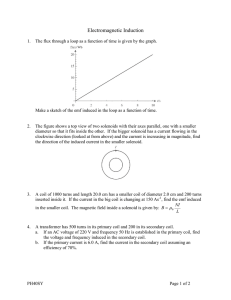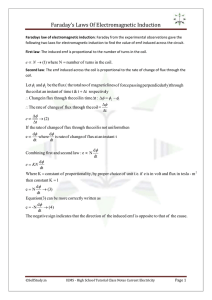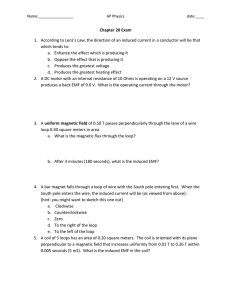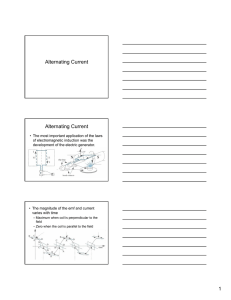Lecture 20 Transformers
advertisement
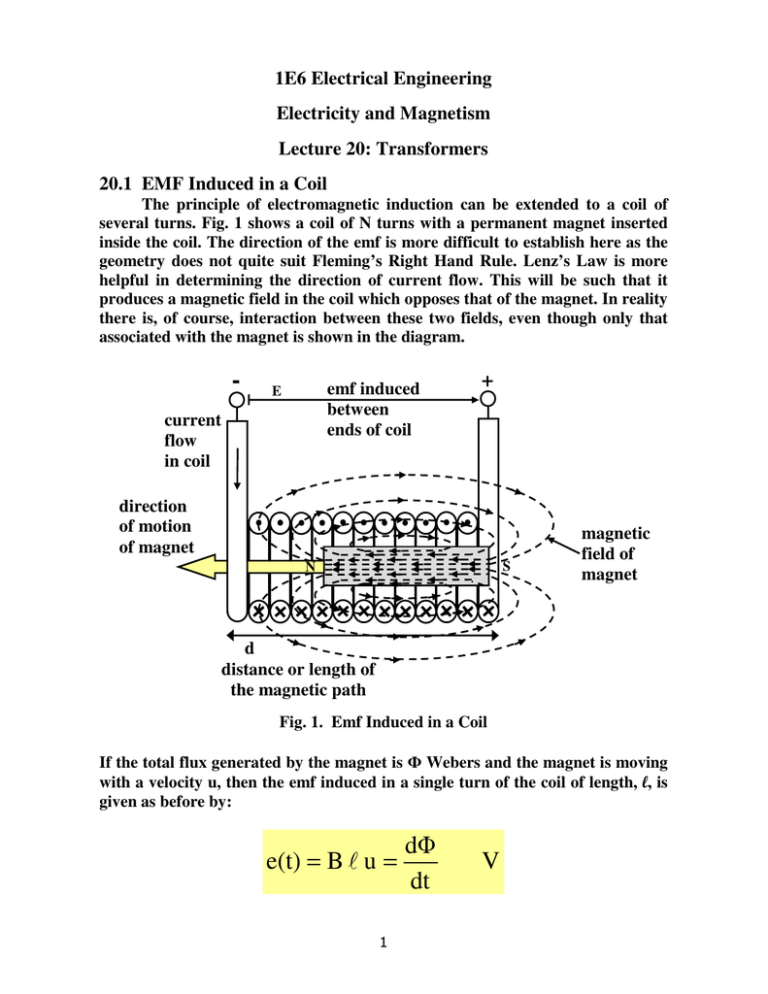
1E6 Electrical Engineering Electricity and Magnetism Lecture 20: Transformers 20.1 EMF Induced in a Coil The principle of electromagnetic induction can be extended to a coil of several turns. Fig. 1 shows a coil of N turns with a permanent magnet inserted inside the coil. The direction of the emf is more difficult to establish here as the geometry does not quite suit Fleming’s Right Hand Rule. Lenz’s Law is more helpful in determining the direction of current flow. This will be such that it produces a magnetic field in the coil which opposes that of the magnet. In reality there is, of course, interaction between these two fields, even though only that associated with the magnet is shown in the diagram. - emf induced between ends of coil E current flow in coil + direction of motion of magnet S N magnetic field of magnet d distance or length of the magnetic path Fig. 1. Emf Induced in a Coil If the total flux generated by the magnet is Ф Webers and the magnet is moving with a velocity u, then the emf induced in a single turn of the coil of length, l, is given as before by: e(t) = B l u = 1 dΦ dt V If, however, the flux of the magnet cuts all of the turns of the coil simultaneously, then this emf is induced into all turns of the coil with cumulative effect so that the total emf induced in a coil having N turns is given as: Induced emf e(t) = N dΦ dt V This result is known as Faraday’s Law 20.2 Faraday’s Experiments In 1831 Michael Faraday (1791-1867), a British physicist/chemist often hailed in England as the father of Electrical Engineering, carried out a number of experiments which are generally accepted as the discovery of electromagnetic induction. One of these is reproduced in Fig. 2 below along with some other illustrations. secondary coil primary coil switch galvanometer battery Fig. 2. Faraday’s Experiment on Electromagnetic Induction 2 In the experiment depicted, the two coils are wound around a magnetic core. The primary coil is connected to a dc battery via a switch while the secondary coil is connected to a Galvanometer, which is a sensitive meter for measuring current. Faraday observed that when he closed the switch, the indicator on the Galvanometer briefly registered a current which quickly decayed to zero. He then observed that when he opened the switch again, the Galvanometer briefly registered a current in the reverse direction of the same magnitude, which again quickly decayed to zero. This was repeated as often and as rapidly as he opened and closed the switch. What occurs is that when the switch is closed, the current flowing in the primary coil induces magnetic flux in the core. While this is being established the flux is changing. The changing flux cuts the secondary coil and induces an emf in this coil which causes current to flow through the Galvanometer. Once the magnetic flux has stabilised, however, its rate of change drops to zero and hence also does the emf and current induced in the secondary coil. When the switch is opened current ceases flowing in the primary coil and consequently the flux in the core decays to zero. While this flux is changing again it induces an emf in the secondary coil in the opposite direction, which then disappears when the flux has decayed to zero. This experiment combines the effects of magnetomotive force generated in the core by the current flowing in the primary coil and the emf induced in the secondary coil by the magnetic flux changing in the core. It proves that electrical energy can be transferred from one circuit to another via the medium of magnetism. This principle is exploited in electrical transformers. It is also important, however, to interpret Lenz’s Law at this point to its full extent. This indicates that when a current flows in the primary coil creating a magnetic flux and inducing an emf in the secondary coil, there is also an opposing emf generated in the primary coil itself which tends to oppose the flow of current and the resulting flux generated. This is referred to as a Back-emf and gives a formal statement of Lenz’s Law as: Back emf e b (t) = − N 3 dΦ dt V 20.3 The Ideal Transformer In Faraday’s experiment the Galvanometer registers a current only for a brief period of time while the magnetic flux is changing. When the flux is constant or zero its rate of change is zero and no emf is induced in the secondary coil under these conditions. If the source driving the primary coil is made an ac sinusoidal source, then the current in the primary coil will be continuously changing. This in turn ensures that the flux in the core is changing continuously and therefore that there is a continuous emf induced in the secondary coil. This is the principle of operation of the transformer an electrical representation of which is shown in Fig. 3. i1(t) magnetic core with path length d i2(t) + primary ac voltage source V1(t) ~ primary winding N1 turns secondary winding N2 turns d output secondary voltage source load V2(t) RL _ Fig.3. Electrical Representation of a Transformer The operation is as follows. The ac voltage source applied to the primary winding, V1(t) causes a current to flow in the primary coil, i1(t). This current then creates a magnetic flux, Ф in the core of the transformer upon which both primary and secondary coils are wound. The flux then links the secondary coil and induces an emf in it which is measured across the output terminals as the voltage, V2(t). If a load is connected to the output of the transformer a current, i2(t) will flow in it, delivering power to the load. If the primary winding is driven with a voltage, V1(t) and the resulting current flowing in this winding is i1(t), then if the primary coil has N1 turns this will create a flux in the core given as: Φ (t) = N1i1 (t) 4 From Lenz’s Law the back-emf generated by this flux will be equal to the source voltage and is given as: dΦ e1 (t) = − N1 = − V1 (t) dt Therefore: dΦ V1 (t) = dt N1 For an ideal transformer it is assumed that all of the flux generated in the core by the primary winding actually cuts the secondary winding also, i.e there is no leakage of flux. If this is the case then the emf induced in the secondary winding which has N2 turns is given as: e 2 (t) = N 2 dΦ = V2 (t) dt so that: dΦ V2 (t) = dt N2 Since the flux is the same cutting both primary and secondary coils the two expressions can be equated to give: V2 (t) V1 (t) = N2 N1 or: N2 V2 (t) = V1 (t) N1 If the source voltage is given as: V1 (t) = V1m Sin ωt 5 Then the secondary output voltage is given by: V2 (t) = N2 V1m Sin ωt N1 so that: N2 V2 (t) = V1m Sin(ωt) = V2m Sin(ωt) N1 From this we can define the fundamental property of the transformer Turns Ratio = n = V2m N 2 = V1m N1 The above relationship shows that the magnitude of the output voltage of the secondary winding is scaled by the turns ratio, n, of the transformer. This can be greater than or less than unity so the magnitude of the secondary output voltage can be made higher, referred to as step-up, or lower, referred to as stepdown, than the primary input voltage. The phase of the secondary voltage can be arranged to be inverted with respect to that of the primary voltage by changing the relative directions of the primary and secondary windings. This can also be accomplished by changing the relative connections to the primary and secondary windings as they are in fact isolated from each other. Moreover, by taking a centre-tap connection off the secondary winding equal anti-phase output voltages can be obtained. This is useful in generating matched positive and negative secondary voltages for use in a dual polarity power supply, for example. Since the turns ratio is a fixed physical property of the transformer the ratio applies to instantaneous, peak or rms values of primary and secondary voltages so that: Turns Ratio = n = N 2 V2 (t) V2 m V2 rms = = = N1 V1 (t) V1 m V1 rms 6 20.4 Case Study 1 A step-down transformer is used to reduce the mains voltage from 220Vrms to a peak secondary voltage of 18Vpk. If the primary winding has 5000 turns determine the number of turns needed on the secondary winding. Solution: If the secondary voltage is 18V pk then the rms value is: V2 rms = 18 = 18 x 0.707 = 12.726 V 2 Then: Turns Ratio = n = N 2 V2 rms 12.726 = = = 0.058 N1 V1 rms 220 so that: N 2 = n x N1 = 0.058 x 5000 = 290 turns 20.5 Current Ratio The main purpose of voltage transformers is to allow power to be delivered to a load at a different voltage to that at which it is generated or distributed, as for example in the case of the distribution of mains domestic electricity. In an ideal transformer there is no loss of power so that all power fed into the primary input of the transformer should be delivered to the load connected to the output of the secondary winding. If average power is made the focus then: P2 AVE = P1 AVE So that: V2 rms I 2 rms = V1 rms I1 rms I 2 rms V1 rms 1 = = I1 rms V2 rms n This shows that the ratio of the currents in a transformer is the inverse of the ratio of the corresponding voltages. 7 20.6 Case Study 2 A transformer fed from a 220V mains supply must deliver 0.55kW of power to a motor which draws a rated current of 10 A rms. The transformer must have a total number of turns of 10,000. Determine: (i) the rated voltage of the motor (ii) the number of turns required on each winding of the transformer (iii) the current which must be supplied to the transformer. Solution: The power which must be delivered to the load is P2 AVE = 0.55 kW = 550 W Then: (i) V2 rms I 2 rms = 550W and I 2 rms = 10 A so that V2 rms = (ii) V1 rms = 220V n= then n = 550 = 55V rms 10 V2 rms 55 = = 0.25 V1 rms 220 N2 = 0.25 ∴ N 2 = 0.25 N1 N1 Total turns is N1 + N 2 = N1 + 0.25 N1 = 1.25N1 = 10,000 then: N1 = 10,000 = 8,000 and N 2 = 0.25N 1 = 0.25 x 8,000 = 2,000 1.25 (iii) I 2 rms 1 = I1 rms n so that I1 rms = nI 2 rms = 0.25 x 10 = 2.5A rms 8 A sample of different types of transformers is shown in Figs 4, 5 and 6 below. Fig. 4 Some Lightweight Transformers for Radio and Power Supply Application Fig. 5 Transformers for Radio. Hi-Fi and Power Supply Applications Fig. 6 Heavy Duty Transformers as used in Domestic and Industrial Power Distribution, e.g in ESB Sub-Stations 9

